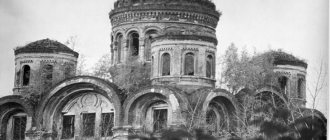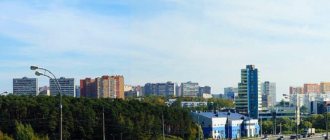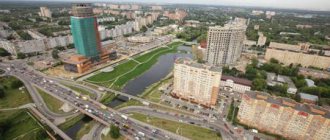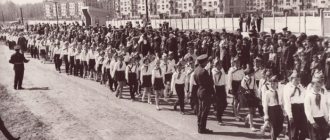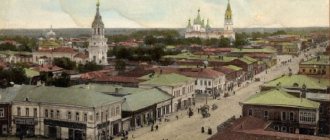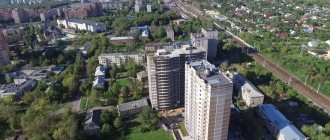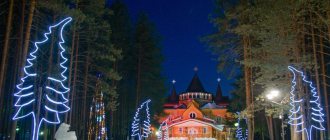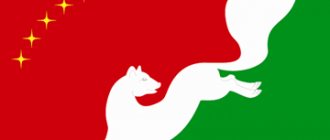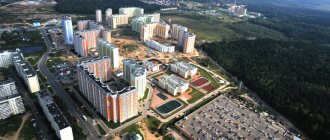06.22.2018 Authors: K. Smirnova, Alexander Popov
- 2004 From the annual directory “Moscow Region”.
- 1988 Booklet by K. Smirnova.
- 1985 From the Soviet Encyclopedic Dictionary.
- 1978 From a set of postcards.
- 1956 From the short guide “Memorable places of the Moscow region.”
- 1869 From the house-to-house census.
About the history of the city of Fryazino
The city got its name from the word “Fryazi” or “Fryazin” - this is how Italians were called in Rus'. Under Ivan III, Italian craftsmen worked actively in the Russian state: they built churches, factories, fortresses, and cast cannons in Moscow, Nizhny Novgorod and Pskov.
The founding date of the city is considered to be 1584, when the first known mention of it was made - in the scribe books of the Moscow district. It talks about the village of Fryazinovo, on the Lyubosivka River. The village belonged to the estates of Bogdan Belsky.
From 1623 to 1781 Fryazino belonged to the noble family of princes Trubetskoy. Their Grebnevo estate included five villages, including Fryazino. It is known that in 1769, 15 peasants of the Trubetskoy princes were engaged in silk weaving. Among them was Fyodor Kondrashev from Fryazino, who became the founder of a rich merchant dynasty.
From 1781 to 1811, the Grebnevo estate belonged to the Bibikov family. Major General Gavrila Ilyich Bibikov is known as the builder of the Grebnevsky estate complex and the first stone church in the Grebnevsky region - the only one of its kind, where the archangel holds a cross on the dome; and also as the owner of his own theater. Bibikov sold his freedom to the Fryazino peasants, who then became influential merchants - the Shuvalovs, Bykovs and Anikins.
From 1811 to 1842 Fryazino belonged to the princes Golitsyn. Under them, a warm “winter” church was built in the village - St. Nicholas the Wonderworker, a hospital and a school for 60 students from peasants and children of church ministers.
Fryazino in the middle of the twentieth century
Since 1842, in the history of Fryazino, the time has come for the Panteleev merchants (who, however, later bought themselves nobility).
In 1901, the first stone factory building was built in the village - the silk weaving factory of Anna Mikhailovna Kaptsova, which could provide work to all residents of Fryazino.
After the revolution and civil war, the enterprise survived, but was idle. In 1929, the Soviet Shelkotrest removed all remaining equipment from it.
In 1933, a factory was organized in the factory building, and construction of a new workers’ village began on the right bank of the Lyuboseevka River. This year marked the birth of Fryazino as the center of the electronics industry of our country.
In 1938, the village received the status of an urban settlement, reaching a population of 6 thousand people. With the beginning of the Great Patriotic War, the plant began producing cups for hand-held anti-tank grenades. In November 1941, the enterprise was evacuated to Tashkent. Already in the spring of 1942, it returned to Fryazino and continued work for the needs of the front: it made radio tubes for mine detectors and radio stations. The 3rd Guards Airborne Brigade was located in the school building. A vocational school was created at the plant.
July 6, 1943 was the birthday of Fryazino as a science city of the electrical engineering industry: on the basis of the Fryazino plant, NII-160 was created with a pilot plant attached to it.
On October 25, 1951, by a resolution of the Supreme Council of the RSFSR, the workers' village of Fryazino was given the status of a city. At that time, 12 thousand people lived in it.
In parallel with industrial construction, active construction of housing and social and cultural institutions was carried out. In 1964, a new one came into operation. Branches of the Institute of Radio Engineering and Electronics of the USSR Academy of Sciences, the Institute of Information Display Devices (Platan Research Institute), and a semiconductor device plant were founded in Fryazino.
Sports Palace "Olympus". 1970.
In subsequent years, the industry developed further, new enterprises and institutions came into operation within its framework.
In the 1990s, a tense economic situation developed in the city, as well as throughout the country. The volume of industrial output fell sharply, along with profits.
On December 29, 2003, the Russian President issued a decree conferring the status of a science city of the Russian Federation on the city of Fryazino. On October 28, 2009, a meeting of the Commission on Modernization and Technological Development of the Russian Economy was held in Fryazino, chaired by Russian President D. A. Medvedev. On December 31, 2015, by decision of the Government of the Russian Federation, a “special economic zone of technology-innovation type “Istok” was created in Fryazino.
The city of Fryazino (booklet 1988, author K. Smirnova)
The young city of Fryazino, which emerged in the post-war years (city status was awarded in 1951), is located 40 km from Moscow along Shchelkovskoe Highway. But these lands have been known since the 16th century. Tourists are obviously interested in finding out where the name of our city came from.
In the second half of the 15th century. Ivan III invites Italian architects to Moscow to build the Kremlin and rewards them with money and land. The small village became the patrimony of Alviz Fryazi. Local peasants quickly renamed him Anton Fryazin, and so the village began to bear the name Fryazino. After the completion of the construction of the Archangel Cathedral in the Kremlin, the master leaves for his homeland, and the lands are transferred to the state treasury. From the 16th century the village of Fryazino became part of the large village of Grebnevo.
Fryazino is associated with the names of outstanding figures of Russian culture. Here is located one of the oldest estates, included in the so-called “Moscow Region”. It is associated with the name of the poet M. M. Kheraskov, the patriarch of Moscow literature, whose work was distinguished by genre diversity. Kheraskov wrote tragedies, “tearful comedies,” poems, and odes. For several years he was the director of Moscow University. Kheraskov spent the summer months of 1760 at his mother’s estate. Artists, musicians, performers rested in the estate, and home performances were staged.
Beautiful forests, sometimes open hilly meadows in lush patterns of flowers, and the poetic small river Lyuboseevka inspired poetic thought. Here Kheraskov completed the epic poem “Rossiyada” - a poem about the heroism of the Russian soldiers of Ivan IV, who conquered the capital of the Tatar Khanate - Kazan. G. R. Derzhavin came to Kheraskov, greeting the owner of the estate:
The creator of the immortal “Rossiyada”, the Sacred Grebnevsky Spring, You gave the poet water to drink.
The estate, which has survived in general terms to this day, acquired a new look at the turn of the 18th-19th centuries. The Bibikovs became its owners. This is an interesting noble family. The sister of the owner of the estate was the wife of the great Russian commander M.I. Kutuzov. The Bibikovs loved music and created an orchestra from serf musicians that enjoyed well-deserved fame. The estate was rebuilt several times; the house, the original entrance gate, and a regular park with ponds have survived to this day. It seems that these ancient buildings will be of interest to tourists.
The scarce lands and forests in the area did not provide the opportunity to engage in arable farming, and the peasants went to work in Moscow and the towns near Moscow.
At the beginning of the 18th century. residents of Fryazin and its environs are involved in industrial production. The textile and silk weaving industry is developing rapidly. Crafts were mainly done at home. At the end of the 18th century. The textile factory of the Kondrashev brothers is being built. She needed cheap labor. Many residents of Fryazin became textile workers. Work at the factory was manual, each weaver brought his own kerosene lamp to the factory, and those coming from distant villages each went to bed at night under their own loom.
The first school in Fryazin opened only in 1812. It was a zemstvo school with a three-year period of study.
After the October Revolution, all lands were nationalized, the first partnerships for joint cultivation of the land were formed in Grebnev, which in 1929 merged into the collective farm named after V.I. Lenin. Today this collective farm is a diversified enterprise, specializing mainly in the production of livestock and crop products.
Gradually the city takes on an industrial face. In 1933, major construction began. But the peaceful life and industrial development of Fryazin were interrupted by the treacherous attack of Nazi Germany on our country. Residents of the city gave all their strength to bring the great Victory closer. Those who were drafted into the army courageously fought the enemy on the fronts of the Great Patriotic War. Many Fryazinians joined the ranks of the people's militia. 31 Hero of the Soviet Union was given by the Fryazino land. The very first in this list of honor is the name of Ivan Ivanovich Ivanov, senior lieutenant, pilot, native of the village of Chizhovo, on whose land the modern city is located. In the first minutes of the war, at 4:25 on June 22, 1941, he rammed a fascist Heinkel. A street in Shchelkovo, Fryazino secondary school No. 1 and a pioneer squad at the school are named after him; A monument to him was erected in Heroes Square.
The close proximity of Fryazin to the industrial facilities of Shchelkov and good communication with Moscow by rail and highway dictated the development of capital housing and social construction in the city. It has been carried out according to a master plan since 1952.
Great success has been achieved in the improvement of Fryazin. It's all kind of fast-moving, with modern tall buildings, beautiful, spacious shops, green, decorated with flower beds. Fryazin has good prospects for the future. In the XII Five-Year Plan, the social and domestic sphere will receive further development. A new school with a swimming pool, classroom system, a sports complex, a shopping center will be built, a children's park will be built, and new residential areas will be put into operation.
The travel and excursion bureau offers residents and guests of the city on excursions introducing Fryazin and its surroundings. It also organizes excursion trips to the hero cities of Moscow, Tula, and to nearby cities - Kaluga, Orel, Smolensk, Vladimir, Suzdal, Yaroslavl and many others. The guides will tell you about deep antiquity and their life today, show you the sights - monuments of history, architecture, ethnography, bright corners of wildlife, introduce you to museums, art galleries, exhibitions.
The bureau organizes three to five-day trips to cities of the Soviet Union, multi-day trips along various tourist routes. The tourist has ample opportunities to get acquainted with the historical and architectural features, landmarks of many cities, with their life and way of life.
Remember, tourism is an active form of recreation. By becoming a tourist, you will enrich yourself with new knowledge about the history of our Motherland, touch with your heart the feat of heroes, the spiritual and cultural values of our people, and discover many new and interesting things from modern life.
We invite you to visit the Fryazino travel and excursion bureau. It will help you choose a tourist route and offer you to take part in interesting excursions.
City of Fryazino.
- M.: Central Advertising and Information Bureau "Tourist", 1988. - 8 p. — (To a tourist about the Moscow region). The author of the text is K. Smirnova. Photo by S. Priymak. Artist G. Nyrkova. Editor N. Zaitsev. Hood. editor L. Ananyeva. Tech. editor I. Golubeva. Proofreader N. Drozdova.
L-83156. Subp. for publication 02/03/87. Academic ed. l. 0.77. Conditional oven l. 0.5. Format 60×90 1/4. Circulation 25,000 copies. Price 25 kopecks. Order 1479. Ed. No. KB-4493.
Commissioned by the Moscow Regional Council for Tourism and Excursions.
Yaroslavl printing plant Soyuzpoligrafproma under the USSR State Committee for Publishing, Printing and Book Trade. 150014, Yaroslavl, st. Svobody, 97.
Estate Grebnevo
The main attraction of the city of Fryazino is rightfully considered an interesting historical and architectural monument - the Grebnevo estate. It is located on the outskirts of the city, on the banks of the Lyuboseevka River. The estate complex is made up of several buildings and structures, each of which has its own semantic and historical meaning.
The main buildings of the Grebnevo estate were erected by General G. I. Bibikov (brother-in-law of M. I. Kutuzov) and S. M. Golitsyn (who received the nickname “the last Moscow nobleman”).
Estate Grebnevo
The historical and architectural complex of the estate and the village of Grebnevo includes the following buildings: the main house of the estate (1780-90); east and west wings (built at the same time); front entrance gate, made in the form of a full-fledged triumphal arch (1821); carriage house, stable, barnyard (19th century); manor fence (mid-18th century); "Golitsyn" hospital (1830-1832); Temple of the Grebnevskaya Icon of the Mother of God (1791); Church of St. Nicholas the Wonderworker (St. Nicholas Church, 1823).
Until recently, these buildings were in a neglected state (except for the temples). Compared to the palace, they were preserved in good condition. But they began to restore the estate to restore it to its former splendor and make it a tourist center.
Population
| Population | ||||||
| 2008[7] | 2009[8] | 2010[9] | 2011[7] | 2012[10] | 2013[11] | 2014[12] |
| 53 005 | →53 005 | ↗55 381 | ↗56 375 | →56 375 | ↗57 265 | ↗58 187 |
| 2015[13] | 2016[14] | 2017[15] | 2018[16] | 2019[17] | 2020[18] | 2021[4] |
| ↗58 946 | ↗59 798 | ↗60 412 | ↗60 441 | ↘59 991 | ↘59 538 | ↘58 942 |
Temple of the Grebnevskaya Icon of the Mother of God
One of the estate's churches was built at the end of the 18th century. Its appearance is very unusual for the architecture of that time. A special feature of this temple is the figure of an angel holding a cross on its main dome. On the temple plaque you can now read the names of those peasants who took an active part in the construction of the church.
Temple of the Grebnevskaya Icon of the Mother of God
The temple building itself is built in the shape of a cross. Its interior decoration is distinguished by exceptional grace and beauty of form. Particularly interesting and unusual is the central iconostasis of the 18th century, which has a concave shape and consists of three decreasing tiers, completed with a crucifix. Of course, in addition to the original decoration, the temple has preserved elements from later periods.
This temple never closed, having successfully worked throughout the Soviet years. In the summer of 2016, the 230th anniversary of its construction and the 225th anniversary of the Great Consecration were widely celebrated.
Location: Grebnevo estate.
St. Nicholas Church (Temple of St. Nicholas the Wonderworker)
St. Nicholas Church traces its history back to the 16th century. For a long time it was wooden. In 1811, the new owner of the Grebnevo estate, Prince Alexander Mikhailovich Golitsyn, decided to replace the dilapidated wooden one with a stone church. The War of 1812 prevented this plan. But in 1817, construction was resumed, and in 1823 the magnificent temple, in the Empire style, rose above Grebnevsky Hill and the surface of the Tsar’s Ponds. This temple “with a bell tower and a clock ringing” became a wonderful symbol of Grebnev. It was consecrated on December 23, 1823. During Soviet times, this church was never closed.
St. Nicholas Church (Temple of St. Nicholas the Wonderworker)
Location: Grebnevo estate.
Church of the Nativity
This is the first temple in the city, built in our time, on the territory of the city hospital. It is not very big and on major holidays it can hardly accommodate everyone who wants to visit it, but it is very beautiful and, according to the testimony of city residents, a very warm and kind atmosphere always reigns in it.
Church of the Nativity
Address: st. Moskovskaya, 9.
Transport sector
The city is being built and developed. Fryanovskoye Highway passes through it. The city itself is located on the seventh kilometer. A bus station was built on Polevaya Street. Operating transport in the city is represented by buses and minibuses. And of course, there is a train station.
It is convenient to get to Fryazino from the capital of Russia by car or public transport. For those who prefer the second option, you can use the train. It will take you from Yaroslavsky Station in Moscow to Fryazino in about an hour. And also by bus - routes No. 361, No. 335.
Abandoned space communications locator
The huge radar of the Space Communications Center is located on the territory of a former military unit, now abandoned. The purpose of this giant P-200 dish antenna with a diameter of 25 meters was to transmit telemetry to high orbits, and it was once used in the unrealized Soviet Mars project.
Abandoned space communications locator
On the territory of the abandoned military unit, in addition to the remains of engineering and auxiliary buildings, there is a pool for cooling operating equipment and another antenna (which was used to control lunar rovers), as well as an underground bunker. Stalkers and lovers of various “abandoned places” often gather to look at the gigantic locator and wander around it.
Economics [edit]
In 1901, Anna Kaptsova founded a large silk weaving factory in the village of Fryazino. It was the first stone building in the village (nationalized in 1918, closed in 1929).
In 1933, the Radiolamp
. From that time on, Fryazino became the center of the Soviet electronics industry. The first research institute NII-160 (the modern name is FSUE NPP Istok) was founded in Fryazino in 1943, then their number increased to five. A branch of the Institute of Radio Engineering and Electronics was founded in Fryazino in 1955.
During Soviet times, growing enterprises operated as part of the Military Armor Institute. With the collapse of the Soviet Union, these institutions were forced to lay off most of their staff. Currently, most of the population of Fryazino works in Moscow.
As part of the defense conversion, research institutes were created: in 1993 - Istok-System, a manufacturer of medical equipment under the Gastroscan brand, in 1994 - Istok-Audio, a manufacturer of hearing aids. In addition to the electronics and medical industries, the city has a confectionery shop and a tea packaging factory. The city also has furniture factories.
In the background in the center is the main building of the Istok Scientific and Production Complex. On the left is the one-story building of the Fryazino-Passenger station, to the left of which there is a railway line to Moscow. Behind it is a snow-covered frozen pond on the Lyuboseevka River.
House-Museum of Hero of the Soviet Union Ivan Ivanovich Ivanov
House-Museum of Hero of the Soviet Union I.I. Ivanov (1909-1941) in the city of Fryazino was built near the lost (burnt down in a fire on October 27, 2008) original house.
Since the fall of 1931, the future Hero of the USSR Ivan Ivanovich Ivanov served in the Red Army. Having graduated with honors from the Odessa Military Pilot School, he became a fighter pilot. He fought on I-16 aircraft in the Soviet-Finnish and Great Patriotic Wars. He died on the first day of the war - June 22, 1941, having committed the first aerial ramming in the history of the war. Having used up his ammunition, he rammed a German bomber and, falling with it, died.
House-Museum of Hero of the Soviet Union Ivan Ivanovich Ivanov
The museum's exposition is housed in three small halls, the first of which is dedicated to the heroic feat of Ivan Ivanovich and tells about the Fryazin heroes who took part in the Great Patriotic War. The personal belongings of Red Army soldiers, their uniforms and equipment, the work of modellers, and an exploding shell embedded in a tree trunk are widely represented.
In the second hall there is a local history exhibition, with photo albums on the history of the city of Fryazino, photo reports about famous people who visited the city, photographs of its construction; panorama of the Grebnevo estate. The third hall is a recreated room of I.I. Ivanov, some of the items in which actually belonged to him and his relatives.
Address: ave. Mira, 26.
Museum
The first Soviet radio, television and one of the first tape recorders can be seen in the Fryazino Museum. The enterprise museum opened in November 2014 and is dedicated to the history of the formation of domestic electronics.
The first Soviet radio receiver of 1936 contained radio tubes developed and produced at the newly created one (the future “Istok”). The first Soviet televisions, released in the late 1940s, were equipped with picture tubes produced by Istok. In the late 60s, the plant produced a semiconductor microwave radio station R-622 (KIT-2), developed for the navy.
Museum
In the 1980s, the plant produced radio relay stations - advanced equipment, which in some cases was ahead of existing foreign analogues. The Sintez-10 airborne radar station had no analogues at all, either in the USSR or abroad.
Samples of this equipment, as well as the “Electronics 004” reel-to-reel tape recorder, are presented in the museum’s collection.
And also - a zenith-centre device, for the construction of high-rise structures (including the Ostankino Tower in Moscow); gastroenterological diagnostic instruments for measuring PH levels in the gastrointestinal tract; hearing aids, which were also produced and are being produced by Istok.
Address: st. Vokzalnaya, 2a.
Notes
- from the point of view of the administrative-territorial structure
- from the point of view of the municipal structure
- (Moscow region. Total area of municipal land
- ↑ 123
The permanent population of the Russian Federation by municipalities as of January 1, 2022 (Russian). Retrieved April 27, 2022. Archived May 2, 2022. - OKTMO. 179/2016. Central Federal District
- Law of the Moscow Region of January 31, 2013 N 11/2013-OZ “On the administrative-territorial structure of the Moscow Region” (as amended on November 25, 2015)
- ↑ 12
Moscow region. Estimated resident population as of January 1, 2009-2016 - The size of the permanent population of the Russian Federation by cities, urban settlements and regions as of January 1, 2009 (unspecified)
. Retrieved January 2, 2014. Archived January 2, 2014. - Population census 2010. Population of Russia, federal districts, constituent entities of the Russian Federation, city districts, municipal districts, urban and rural settlements (Russian). Federal State Statistics Service. Access date: January 22, 2013. Archived April 28, 2013.
- Population of the Russian Federation by municipalities. Table 35. Estimated resident population as of January 1, 2012 (unspecified)
. Retrieved May 31, 2014. Archived May 31, 2014. - Population of the Russian Federation by municipalities as of January 1, 2013. - M.: Federal State Statistics Service Rosstat, 2013. - 528 p. (Table 33. Population of urban districts, municipal districts, urban and rural settlements, urban settlements, rural settlements) (undefined)
. Retrieved November 16, 2013. Archived November 16, 2013. - Table 33. Population of the Russian Federation by municipalities as of January 1, 2014 (unspecified)
. Access date: August 2, 2014. Archived August 2, 2014. - Population of the Russian Federation by municipalities as of January 1, 2015 (unspecified)
. Access date: August 6, 2015. Archived August 6, 2015. - Population of the Russian Federation by municipalities as of January 1, 2016 (Russian) (October 5, 2018). Retrieved May 15, 2022. Archived May 8, 2022.
- Population of the Russian Federation by municipalities as of January 1, 2022 (Russian) (July 31, 2017). Retrieved July 31, 2022. Archived July 31, 2022.
- Population of the Russian Federation by municipalities as of January 1, 2022 (Russian). Retrieved July 25, 2018. Archived July 26, 2022.
- Population of the Russian Federation by municipalities as of January 1, 2022 (Russian). Retrieved July 31, 2019. Archived May 2, 2022.
- Estimation of the permanent population of the Moscow region as of January 1, 2022 and on average for 2022 for municipalities (unspecified)
. Mosoblaststat. Access date: April 20, 2022. - Population of the Russian Federation by municipalities as of January 1, 2022 (Russian). Date accessed: October 17, 2022. Archived October 17, 2022.
- Charter of the Fryazino urban district, 2010, Article 21.
- Charter of the Fryazino urban district, 2010, Article 22.
- Charter of the Fryazino urban district of the Moscow region / fryazino.org (unspecified)
.
fryazino.org
. Access date: July 12, 2022. - Charter of the Fryazino urban district, 2010, Article 26.1.
- Charter of the Fryazino urban district, 2010, Article 28.
- Charter of the Fryazino urban district, 2010, Article 30.
- Charter of the Fryazino urban district, 2010, Article 31.
- Head of the Fryazino City District // Official website of the Fryazino City District
- Management and structural units of the administration of the city of Fryazino // Official website of the Fryazino city district
Palace of Culture "Istok"
The Istok Palace of Culture is the main center of culture and creativity in the city of Fryazino. It has been operating since 1969. The Palace of Culture has two halls - a large one for 670 people and a small one for 200 people; there are various clubs and studios, as well as a summer creative camp “Zvezda”.
Palace of Culture "Istok"
Address: st. Komsomolskaya, 17.
Fryazino (from the short guide “Memorable places of the Moscow region”, 1956)
The city of Shchelkovsky district and the station of the Bolshevo-Ivanteevka-Fryazino branch of the Northern railway. d. From Moscow - 53 km. (Bus No. 29 from Preobrazhenskaya Zastava.)
Fryazino is the youngest city in the Moscow region, it is a little over two years old. It was formed from a village of the same name. Its straight, wide, asphalt-covered streets: Moskovskaya, Tsentralnaya, Institutskaya, etc., are lined with multi-story buildings. Thousands of trees and shrubs are planted along the streets.
Buses run from Fryazin to the regional center - Shchelkovo and to Moscow. The city has medical institutions, schools, kindergartens, nurseries, a children's music school, and a stadium. A new club with an auditorium for 650 seats was built.
Memorable places of the Moscow region
: A short guide. — 2nd ed., add. and processed - M.: Moscow worker, 1956. Moscow Regional Museum of Local Lore.
Compiled by: E. B. Burykh, V. M. Kolobov, Yu. A. Skotnikov, S. S. Tikhonovich, T. I. Shepovalov.
Avenue of Heroes
Alley of Heroes is a memorial place located in the old part of the city of Fryazino. It is located between a building with a large beautiful arch and the Church of the Nativity of Christ. This is a memorial in honor of heroes - natives of the city who performed outstanding feats during the Great Patriotic War. In the center of the Alley there are three busts of Fryazinians - Heroes of the Soviet Union: I.I. Ivanov, A.G. Dudkin and B.N. Eryashev. Around the alley there are sports and children's playgrounds, benches and other recreation areas.
Avenue of Heroes
Alley of Labor Heroes
In the park on Victory Square there are busts of Fryazinians who made a particularly significant contribution to the formation and development of the city and its city-forming enterprise -. These are, in particular, the director of Istok Sergei Ivanovich Rebrov, academician Nikolai Dmitrievich Devyatkov, scientific director and general designer Larisa Anatolyevna Paryshkuro, toolmaker Vladimir Ivanovich Volk and other distinguished people.
Alley of Labor Heroes
Memorial to Fryazinians who died in the Great Patriotic War
A memorial in honor of all Fryazino residents who died during the Great Patriotic War was erected in 1986 on Victory Square, not far from the Fryazino railway station.
Memorial to Fryazinians who died in the Great Patriotic War
The central part of the memorial to the Fryazin soldiers was a bronze sculpture of a Soviet soldier, depicted standing on a guard of honor with the red banner of Victory. This sculpture is installed on a high, granite-lined pedestal. It bears a gilded commemorative inscription: “To the Fryazinian soldiers who fell in battles for the victory of the Fatherland 1941-1945.” Behind the monument there is a white stele.
Monument to Living and Fallen Soldiers and Participants in Local Conflicts
The monument was erected in the park on Vokzalnaya Street, between the Fakel club and the bathhouse. On the pediment of the monument is a quote from the Prussian and Russian military leader of the early 19th century, Carl von Clausewitz: “War is nothing more than the continuation of state policy by other means.” And on the base there is a list of wars and local conflicts in which Soviet and Russian soldiers took part.
Monument to Living and Fallen Soldiers and Participants in Local Conflicts
Neighborhood
The climate in Fryazino is temperate continental. Forests alternate with swamps. Most of the fields are under cultivation. A large lake appeared on the site of the Bulygin peat bogs, and Barskie ponds are located in the vicinity. These are some of the most picturesque places in the Meshchera Lowland. In summer you can have a wonderful time outdoors here. The field has mowed areas, a volleyball net, and you can play football. The presence of a reservoir allows you to fish and ride inflatable boats. There is a small pier from which you can dive. A makeshift bridge leads to an island in the middle of the pond.
